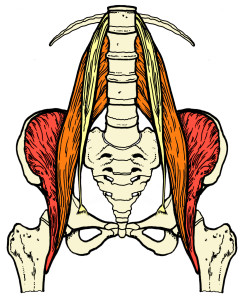
The psoas major, the body’s main engine of walking, is one of three muscles that make up the iliopsoas muscle group.
The psoas major inserts on the back half of the inner thigh, comes forward to cross over the rim of the pelvis and moves back again to attach along the lumbar or lower spine.
The iliacus muscle lines the inside wall of the pelvis and joins psoas major to form a common tendon inserting together on the back half of the inner thigh.
Psoas minor is an interesting muscle that anatomy books will tell you is present in only 50% of people and is slowly disappearing.
As an aside, I have a friend who went to a cadaver lab and checked 39 bodies for a psoas minor and found 1.
Psoas major attaches at six points. The back of the inner thigh and then five different points along the spine. These include the first four vertebrae of the lumbar spine (lower back), and the bottom vertebrae of the thoracic spine (T12). The thoracic spine is the middle back and is the connection point for the ribs.
As a result the psoas spans and affects many joints as opposed to the iliacus which only crosses the one joint where the leg meets the pelvis.
The psoas is unique for many reasons.
• Only three muscles connect the legs to the spine. The psoas major, the gluteus maximus and the piriformis.
• 57 muscles attach on the pelvis. The psoas, which doesn’t attach to the pelvis, is arguably more influential in regards to the pelvis than any of them.
• Your psoas is intimately connected to breathing as the diaphragm muscle, the main muscle of respiration, has ligaments that wrap around the top of the psoas and two long attachments, called crura, that come down to insert on the first three vertebrae of the lower spine.
This means that every breath resonates in some way with the psoas and the movement of the psoas can have great influence on the breath.
• The Psoas major moves in more than one direction as it comes diagonally forward to cross over the rim of the pelvis and then moves straight up to connect to the lumbar spine. Not many muscles change direction.
• The psoas major is the main muscle of walking. Walking is a full body experience initiated in the trunk and extending out through the extremities. The psoas, from the deepest core, moves the legs rather than the legs moving the body.
In a weird way you can say the leg begins up at the top of the psoas as truly fluid movement in walking is felt as a pendulum-like release from the base of the rib cage at T12.
• The Psoas major is the body’s main hip flexor which is why it is the main muscle of walking but it plays a deeper maybe more important role as a flexor.
Flexion is the one of the ways we manifest our distress, fear and trauma. Our inability to process these experiences and emotions create imbalances that often affect the psoas.
For certain extreme cases it is like living in a state of constant flexion.
Fear is flexion and the world is a scary place. Scarier for some than others but scary nevertheless.
Unprocessed fear lives in the psoas.
